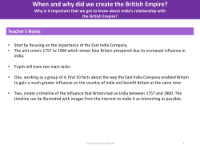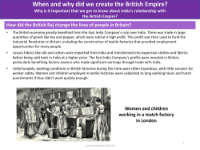India and the British Empire - Info pack

History Resource Description
The establishment of the East India Company in 1600 by Queen Elizabeth I marked the beginning of a significant era in the relationship between Britain and India. This private trading firm, driven by the ambition of merchants to profit from Asian trade, sought spices, cotton, and indigo dye. Over time, Britain's influence in India grew, especially after 1757 when the East India Company began exerting more control. This eventually led to direct British governance starting in 1858, known as the British Raj, which had a considerable impact on India. The British Raj era was characterized by the wealth accumulation of the British government and certain individuals through trade, which contributed to funding the Industrial Revolution. However, it was also a period in which many Indians faced extreme poverty and famines.
The East India Company initially aimed to compete with Dutch, French, and Portuguese merchants in the East Indies, but eventually focused on Southern India due to intense competition. In 1639, the company established a foothold by purchasing land and building Fort St George, now a part of modern-day Chennai. Relations with the Mughal rulers were initially cordial, as trade was mutually beneficial. However, by the end of the 17th century, tensions rose, leading to the Anglo-Mughal War. Despite losing to Mughal Emperor Aurangzeb, the English were allowed to continue trading with a fine, as the emperor was preoccupied with other threats. The Battle of Plassey in 1757 was a pivotal moment, where the British, led by Robert Clive and aided by betrayal within the Nawab of Bengal's ranks, secured a victory that paved the way for increased British control over India.





